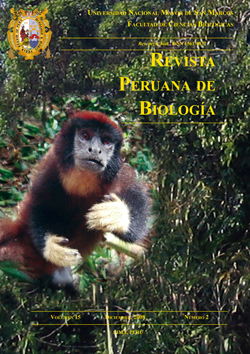Toxic activity of Argemone subfusiformis Ownb. and Tagetes patula Link against Aedes aegypti L. fourth instar larvae and pupae
DOI:
https://doi.org/10.15381/rpb.v15i2.1733Keywords:
Biopesticide, dengue, botanicalsAbstract
The aim of this research work was evaluate toxic activity of ethanolic extracts from Argemone subfusiformis “Holy thistle” & Tagetes patula “French marigold” leaves against Aedes aegypti fourth instar larvae and pupae were evaluated. Bioassay and extract processing were performed in Entomology Laboratory of National University of Trujillo, Perú, from April to December, 2007, outlined by World Health Organization (2005) standard protocol. Larvae and pupae mortality rates reached using A. subfusiformis extract were 100% with concentrations of 76,8 mg/L. and 153,6 mg/L. at 12 hours of exposure, while pupae mortality was to a concentration of 153,6 mg/L. at 24 hours of exposure. By using T. patula extract mortality rates reached were 92% and 77% on larvae and pupae, respectively with a concentration of 153,6 mg/L. at 48 hours of exposure. A. subfusiformis extracts showed LC50 and LC90 values at 48 hours on larvae which were 6,24 mg/L. and 9,91 mg/L. and pupae LC50 and LC90 values were 9,45 mg/L. and 16,92 mg/L. T patula extracts showed LC50 and LC90 values at 48 hours on larvae which were 72,21 mg/L. and 137,37 mg/L. and pupae LC50 and LC90 values were 89,1 mg/L. and 167,38 mg/L. According to ANAVA were observed significant difference among four times of exposure and five concentration levels. Larvae and pupae susceptibilities were assessed by means of log-dosage/probit lines. Both species showed leaf toxic activities against A. aegypti fourth instar larvae and pupae, being the major values of mortality to A. subfusiformis.Downloads
Downloads
Published
Issue
Section
License
Copyright (c) 2008 Judith Vidal, Aida Carbajal, Manuel Sisniegas, Miguel Bobadilla

This work is licensed under a Creative Commons Attribution-NonCommercial-ShareAlike 4.0 International License.
AUTHORS RETAIN THEIR RIGHTS:
a. Authors retain their trade mark rights and patent, and also on any process or procedure described in the article.
b. Authors retain their right to share, copy, distribute, perform and publicly communicate their article (eg, to place their article in an institutional repository or publish it in a book), with an acknowledgment of its initial publication in the Revista Peruana de Biologia.
c. Authors retain theirs right to make a subsequent publication of their work, to use the article or any part thereof (eg a compilation of his papers, lecture notes, thesis, or a book), always indicating its initial publication in the Revista Peruana de Biologia (the originator of the work, journal, volume, number and date).






